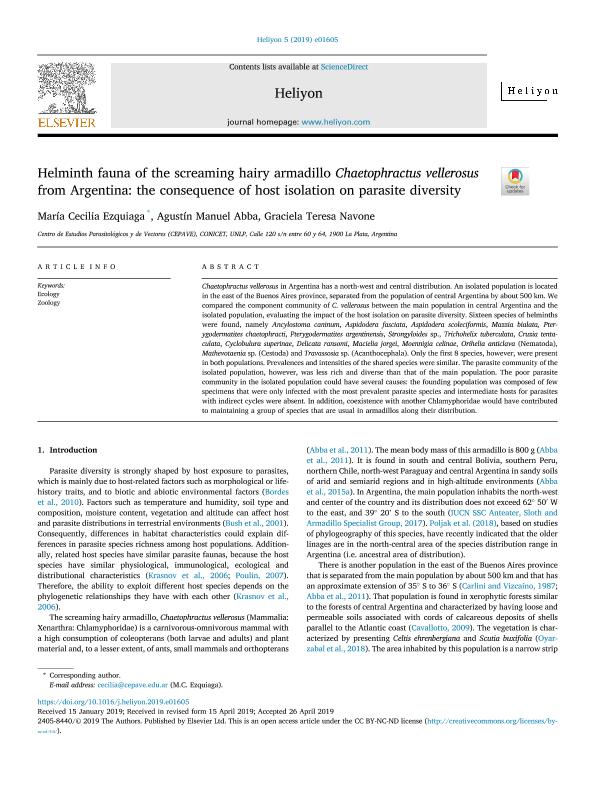Mostrar el registro sencillo del ítem
dc.contributor.author
Ezquiaga, María Cecilia

dc.contributor.author
Abba, Agustin Manuel

dc.contributor.author
Navone, Graciela Teresa

dc.date.available
2021-01-11T13:49:01Z
dc.date.issued
2019-05
dc.identifier.citation
Ezquiaga, María Cecilia; Abba, Agustin Manuel; Navone, Graciela Teresa; Helminth fauna of the screaming hairy armadillo Chaetophractus vellerosus from Argentina: the consequence of host isolation on parasite diversity; Elsevier; Heliyon; 5; 5; 5-2019; 1-5
dc.identifier.issn
2405-8440
dc.identifier.uri
http://hdl.handle.net/11336/122169
dc.description.abstract
Chaetophractus vellerosus in Argentina has a north-west and central distribution. An isolated population is located in the east of the Buenos Aires province, separated from the population of central Argentina by about 500 km. We compared the component community of C. vellerosus between the main population in central Argentina and the isolated population, evaluating the impact of the host isolation on parasite diversity. Sixteen species of helminths were found, namely Ancylostoma caninum, Aspidodera fasciata, Aspidodera scoleciformis, Mazzia bialata, Pterygodermatites chaetophracti, Pterygodermatites argentinensis, Strongyloides sp., Trichohelix tuberculata, Cruzia tentaculata, Cyclobulura superinae, Delicata ransomi, Macielia jorgei, Moennigia celinae, Orihelia anticlava (Nematoda), Mathevotaenia sp. (Cestoda) and Travassosia sp. (Acanthocephala). Only the first 8 species, however, were present in both populations. Prevalences and intensities of the shared species were similar. The parasite community of the isolated population, however, was less rich and diverse than that of the main population. The poor parasite community in the isolated population could have several causes: the founding population was composed of few specimens that were only infected with the most prevalent parasite species and intermediate hosts for parasites with indirect cycles were absent. In addition, coexistence with another Chlamyphoridae would have contributed to maintaining a group of species that are usual in armadillos along their distribution.
dc.format
application/pdf
dc.language.iso
eng
dc.publisher
Elsevier

dc.rights
info:eu-repo/semantics/openAccess
dc.rights.uri
https://creativecommons.org/licenses/by-nc-nd/2.5/ar/
dc.subject
ECOLOGY
dc.subject
ZOOLOGY
dc.subject.classification
Otros Tópicos Biológicos

dc.subject.classification
Ciencias Biológicas

dc.subject.classification
CIENCIAS NATURALES Y EXACTAS

dc.title
Helminth fauna of the screaming hairy armadillo Chaetophractus vellerosus from Argentina: the consequence of host isolation on parasite diversity
dc.type
info:eu-repo/semantics/article
dc.type
info:ar-repo/semantics/artículo
dc.type
info:eu-repo/semantics/publishedVersion
dc.date.updated
2020-11-20T17:16:01Z
dc.journal.volume
5
dc.journal.number
5
dc.journal.pagination
1-5
dc.journal.pais
Países Bajos

dc.journal.ciudad
Amsterdam
dc.description.fil
Fil: Ezquiaga, María Cecilia. Consejo Nacional de Investigaciones Científicas y Técnicas. Centro Científico Tecnológico Conicet - La Plata. Centro de Estudios Parasitológicos y de Vectores. Universidad Nacional de La Plata. Facultad de Ciencias Naturales y Museo. Centro de Estudios Parasitológicos y de Vectores; Argentina
dc.description.fil
Fil: Abba, Agustin Manuel. Consejo Nacional de Investigaciones Científicas y Técnicas. Centro Científico Tecnológico Conicet - La Plata. Centro de Estudios Parasitológicos y de Vectores. Universidad Nacional de La Plata. Facultad de Ciencias Naturales y Museo. Centro de Estudios Parasitológicos y de Vectores; Argentina
dc.description.fil
Fil: Navone, Graciela Teresa. Consejo Nacional de Investigaciones Científicas y Técnicas. Centro Científico Tecnológico Conicet - La Plata. Centro de Estudios Parasitológicos y de Vectores. Universidad Nacional de La Plata. Facultad de Ciencias Naturales y Museo. Centro de Estudios Parasitológicos y de Vectores; Argentina
dc.journal.title
Heliyon
dc.relation.alternativeid
info:eu-repo/semantics/altIdentifier/url/https://www.sciencedirect.com/science/article/pii/S2405844019304840?via%3Dihub
dc.relation.alternativeid
info:eu-repo/semantics/altIdentifier/doi/http://dx.doi.org/10.1016/j.heliyon.2019.e01605
Archivos asociados
